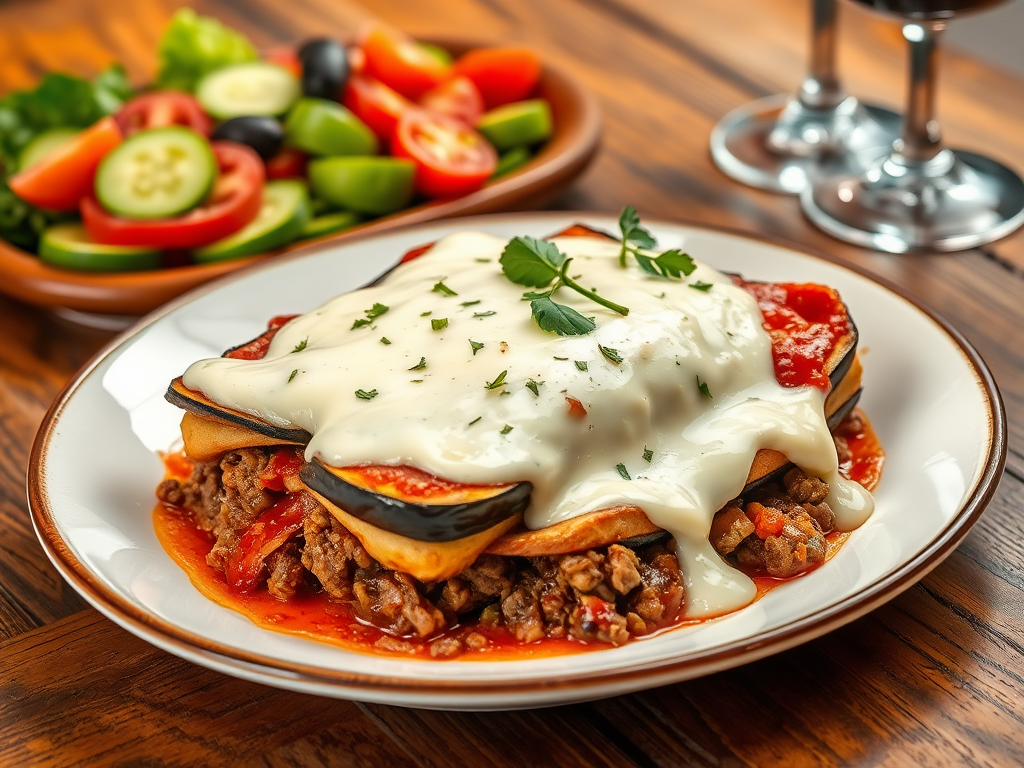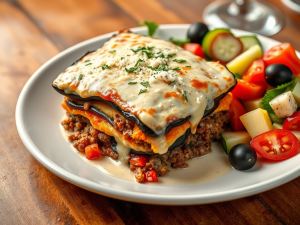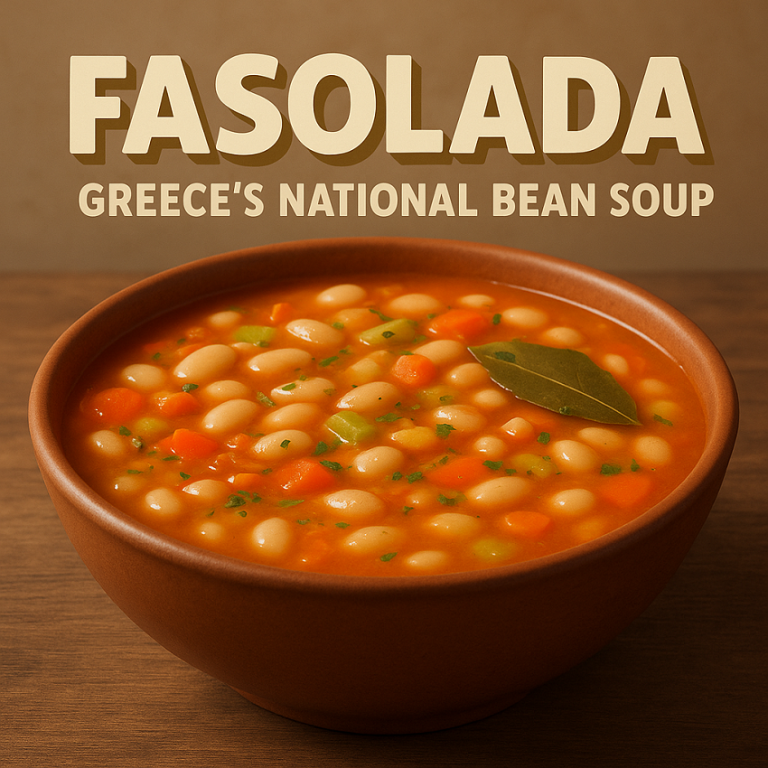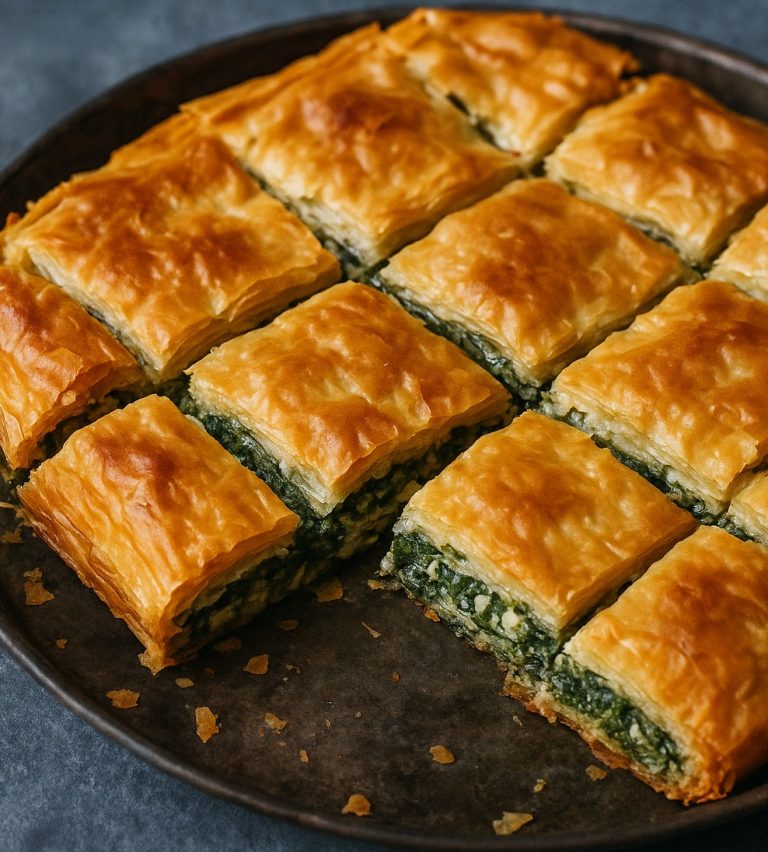
Greek moussaka is a popular meal that showcases the wonderful flavors of Greece. This hearty dish features layers of eggplant, ground meat, and creamy béchamel sauce, making it a favorite for many families and restaurants.
History
Moussaka has a rich history that goes back to the Middle East, where similar dishes have been enjoyed for centuries. The Greek version became famous in the late 1800s. Chef Nikolaos Tselementes played a crucial role in popularizing moussaka by introducing béchamel sauce, which gives the dish a rich, creamy texture. Over time, moussaka has become a beloved symbol of Greek cuisine, often served during special occasions and family gatherings.
Main Ingredients
1. Eggplants
Eggplants are a key ingredient in moussaka. They add a unique texture and flavor to the dish. Typically, they are sliced into rounds, salted to draw out moisture, and then either fried or baked until golden brown. This process enhances their taste and ensures they are tender.
2. Ground Meat
Most recipes use a mix of ground lamb and beef, which adds a rich flavor to the dish. The meat is cooked with chopped onions, garlic, and spices such as cinnamon and nutmeg. These spices give the meat sauce a warm and aromatic profile, making it delicious and comforting.
3. Tomato Sauce
Tomato sauce plays an important role in balancing the rich flavors of the meat and eggplant. It adds a sweet and tangy note that brightens the overall taste. You can use homemade sauce or store-bought for convenience, but homemade often tastes best.
4. Béchamel Sauce
The béchamel sauce is what sets moussaka apart from other casseroles. Made from butter, flour, milk, and eggs, it creates a smooth and creamy topping. When baked, it forms a golden crust that is both tasty and visually appealing.
5. Cheese
Grated cheese, often kefalotyri or Parmesan, is sprinkled on top of the béchamel sauce. This adds an extra layer of flavor and creates a deliciously crispy crust when baked.
How to Make Moussaka
Step 1: Prepare the Eggplants
- Slice the eggplants into rounds, about half an inch thick. Sprinkle with salt and let them sit for about 30 minutes. This process helps draw out moisture and bitterness from the eggplants.
- Rinse the eggplants under cold water and pat them dry with paper towels. Then, fry or grill the slices until they are golden brown. This step adds flavor and softens the eggplants.
Step 2: Make the Meat Sauce
- In a large skillet, heat some olive oil over medium heat. Add chopped onions and sauté until they are soft and translucent.
- Add the ground meat and cook until it is browned and cooked through. Break it up with a spoon as it cooks.
- Stir in diced tomatoes, minced garlic, and spices like cinnamon and nutmeg. Let the mixture simmer for about 15-20 minutes until it thickens. This allows the flavors to meld beautifully.
Step 3: Make the Béchamel Sauce
- In a saucepan, melt butter over medium heat. Once melted, whisk in flour to create a roux. Cook for a few minutes until it turns a light golden color.
- Gradually add milk, whisking continuously to avoid lumps. Keep stirring until the sauce thickens.
- Remove the saucepan from heat and allow it to cool slightly. Then, whisk in egg yolks and grated cheese until well combined.

Step 4: Assemble the Moussaka
- Preheat your oven to 350°F (175°C).
- In a baking dish, spread half of the eggplant slices in an even layer. Top with the meat sauce, spreading it evenly.
- Layer the remaining eggplant slices on top of the meat sauce.
- Pour the béchamel sauce over everything, smoothing it out with a spatula. Sprinkle additional grated cheese on top for a crispy finish.
- Bake in the preheated oven for about 45 minutes, or until the top is golden brown and bubbly.
Serving Suggestions
Moussaka is best served warm, allowing the flavors to meld beautifully. It can be enjoyed as a main dish or paired with a simple Greek salad made of fresh tomatoes, cucumbers, olives, and feta cheese. A glass of robust red wine or a refreshing ouzo can enhance the dining experience, making it feel even more special.
Variations
There are many ways to enjoy moussaka, and various regions have their own interpretations. Some people like to add layers of potatoes or zucchini, while others might use different types of ground meat. Vegetarian versions often substitute the meat with lentils or mushrooms, making it accessible for those who prefer plant-based meals. Each variation offers a unique twist on the classic dish, allowing everyone to find a version they love.
Conclusion
Greek moussaka is not just a dish; it represents Greek culture and tradition. Its layers of flavor, comforting texture, and rich history make it a standout meal for family gatherings or special occasions. Whether you’re making it for the first time or perfecting a family recipe, moussaka is sure to bring joy to your table. Enjoy the process of cooking and the delicious results that follow.



